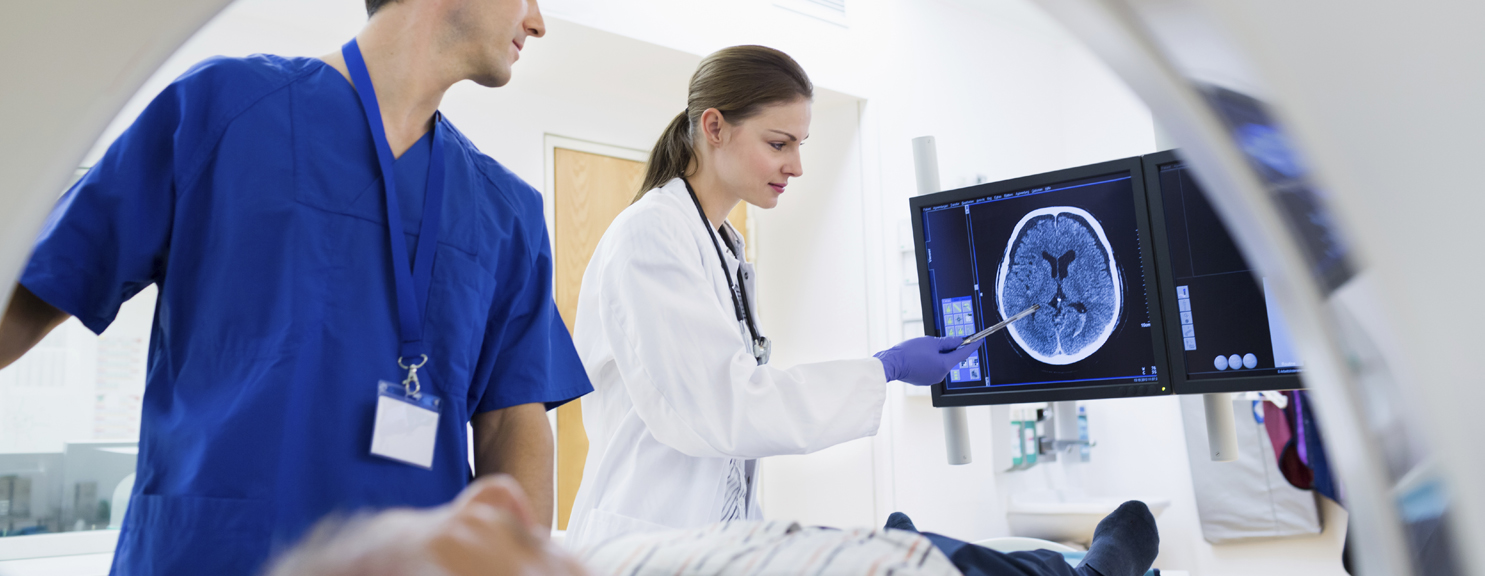What Do Nuclear Medicine Technologists Do?
Nuclear medicine technologists (NMTs) use a scanner to create images of various areas of a patient’s body. They prepare radioactive drugs and administer them to patients and then monitor the characteristics and functions of tissues or organs in which the drugs localize. The radioactive drugs cause abnormal areas of the body to appear different from normal areas in the images. The particular drugs NMTs are trained to use are made from radioactive materials (radionuclides), which can help physicians detect and treat diseases. NMTs also operate the diagnostic imaging equipment that scans, detects, and maps the radioactive drug through a patient’s body to create images. The images are then produced on a computer screen or on film for a physician to interpret.
Nuclear medicine differs from other diagnostic imaging technologies because it determines the presence of disease on the basis of metabolic changes rather than changes in organ structure.
To learn more about this profession, go to: http://www.bls.gov/ooh/healthcare/nuclear-medicine-technologists.htm.
Where Do Nuclear Medicine Technologists Work?
The majority of NMTs are employed by hospitals, although a smaller number of NMTs are employed in the offices and clinics of physicians or in imaging clinics.
What Do Nuclear Medicine Technologists Earn?
In 2022, the average annual income reported by the Bureau of Labor Statistics (BLS) for nuclear medicine technologists in the United States was $89,610. The New York State Department of Labor (NYSDOL) reports that, in 2023, nuclear medicine technologists in New York earned a median annual salary of $103,820 (nuclear medicine technologists in the 25th percentile made approximately $82,328 while those in the 75th percentile made approximately $111,588).
Supply and Demand
The Bureau of Labor Statistics projects that the number of jobs for nuclear medicine technologists in the U.S. will increase by 2% between 2021 and 2031. The New York State Department of Labor projects that the number of jobs for in the state will increase by 16% between 2020 and 2030.
Employment of nuclear medicine technologists is projected to grow slower than the average of all occupations. An aging population may lead to the need for nuclear medicine technologists who can provide imaging to patients with certain medical conditions, such as heart disease. However, employment growth may be tempered as many medical facilities and third-party payers encourage the use of less costly, noninvasive imaging technologies, such as ultrasound. For more information on NMTs by New York State labor regions, 2018-2028, click here.
New York Educational Requirements
NMTs are trained in nuclear medicine technology education programs that range from one to four years in length and lead to a certificate, associate, or bachelor’s degree. Some NMTs become qualified by completing an associate’s or a bachelor’s degree program in a related health field, such as radiologic technology or nursing, and then completing a one-year certificate program in nuclear medicine technology. Courses for becoming an NMT include human anatomy and physiology, physics, chemistry, biological effects of radiation exposure, radiation protection and procedures, the use of radiopharmaceuticals, imaging techniques, and computer science. NMT education programs also include clinical experience–to practice under the supervision of a certified NMT and a physician who specializes in nuclear medicine.
New York Licensure Requirements
New York does not require NMTs to be licensed though most employers prefer to hire certified NMTs. Individuals wishing to demonstrate proficiency in their occupation may receive certification through national organizations such as the American Registry of Radiologic Technologists, http://www.arrt.org or from the Nuclear Medicine Technology Certification Board, www.nmtcb.org. ARRT and NMTCB have different requirements, but each require that an NMT must pass a comprehensive exam to become certified.
NMTs must meet the minimum federal standards on the administration of radioactive drugs and the operation of radiation detection equipment. In addition to the general certification requirements, certified NMTs must also complete a certain number of continuing education hours. This is required primarily because of the frequent technological and innovative changes in the field of nuclear medicine. Typically, NMTs must register annually with both the ARRT and the NMTCB.
Financial Support
Students seeking an education in nuclear medicine technology may apply for grants, awards, and scholarships through the Society of Nuclear Medicine and Molecular Imaging. Students can also apply for financial aid through a number of state and federal aid programs. More information is available at: www.highered.nysed.gov/NYLearns.
Education Programs in New York (subject to change)
| Bronx Community College (affiliated with Montefiore The University Hospital for the Albert Einstein College of Medicine) 2155 University Avenue Bronx, NY 10453 (718) 289-5930 or (718) 289-5100 |
University at Buffalo State University of New York 105 Parker Hall South Campus Buffalo, NY 14214-3007 (716) 645-6900 ext.135 |
| Manhattan College Radiological and Health Professions 4513 Manhattan College Parkway Riverdale, NY 10471 (718) 862-7370 or (718) 862-8000 |
Molloy University 1000 Hempstead Avenue Rockville Centre, NY 11571-5002 (516) 678-5000 ext. 6887 or 1-800-4-MOLLOY |
Additional Web Links
For more information about NMTs go to The American Society of Nuclear Medicine Web site at: http://www.snmmi.org/ACNM/index.aspx.
[whohit]Nuclear Medicine Technologists[/whohit]

